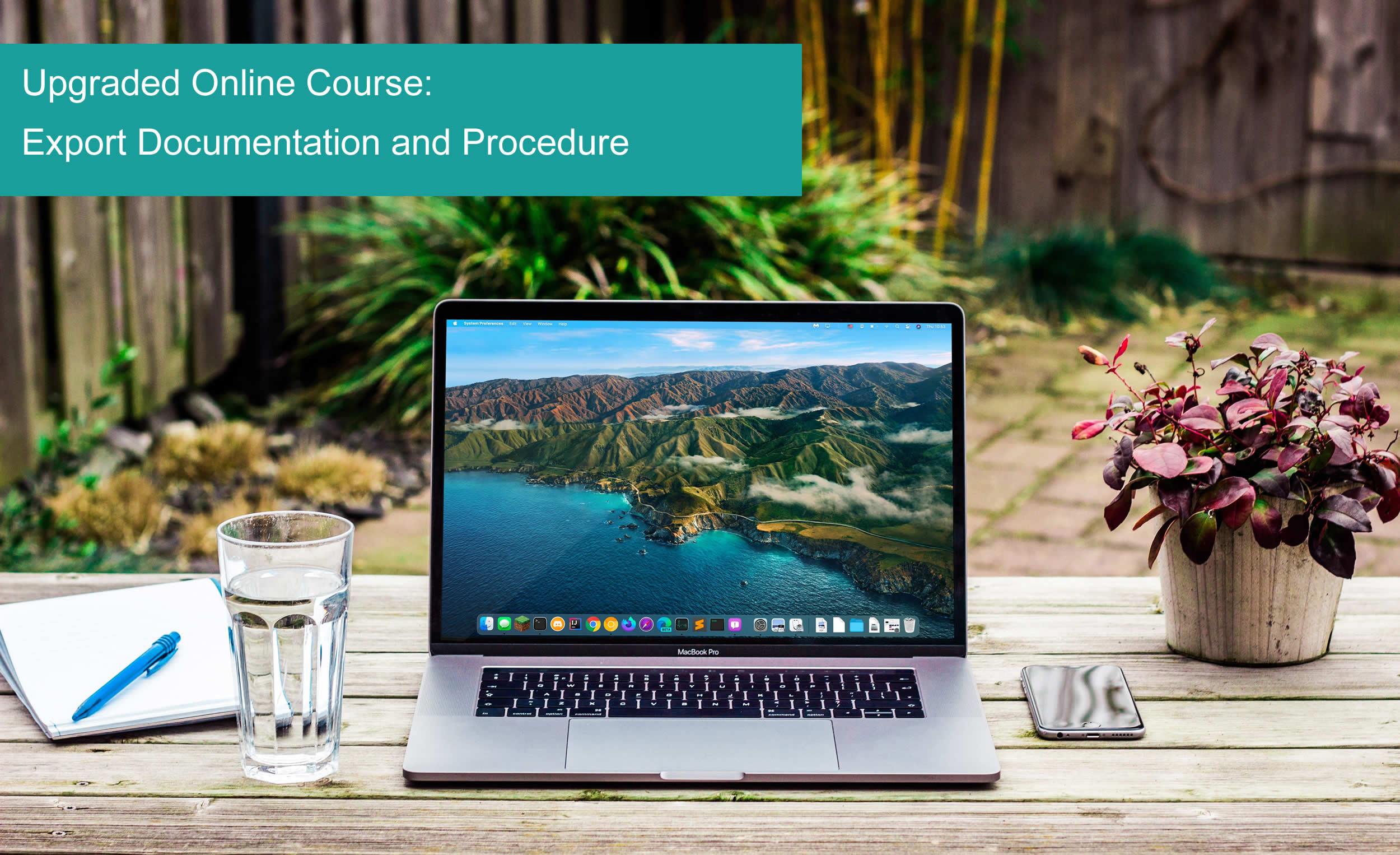Upgraded Online Course Now Available For 2024

Our upgraded “Export Documentation and Procedure” course teaches you practical lessons you need to know to move your goods around the world. Developed by Alan Bracken, with over 35+ years of commercial experience in international trade.
Alan setup and built his own freight forwarder business which he went on to sell, so has extensive commercial experience in logistics with a deep understanding of export documentation.
He explains what can be complicated subjects, in easy-to-understand ways, teaching you to be proactive, no reactive, giving you excellent foundation knowledge of export procedure.
Course cost is just £499, enroll now.
As a foreign buyer, it can be extremely confusing when you want to import goods from a particular country. Knowing what countries require, how things have changed for the UK after leaving the European Union, whether you need an EORI number and whether or not you need an export license are all common questions.
To have a deep understanding of shipping documents, common export documents, export regulations, customs duties and customs declarations, it takes an extensive level of study to understand the entire process so in this blog, we’re just going to introduce the basics of how to export goods and give you as much correct information as we can in plain English.
We’re actually going to address the the following questions as we’re asked these the most often.
Common Export Documents (The Basics):
- What is a Bill of Lading?
- A Document of Title
- Evidence of the Contract of Carriage
- Negotiable or Non-Negotiable?
- What is Clean and Claused?
- What is a Certificates of Origin?
- Why is a Certificate of Origin Needed?
- Why is a Certificate of Origin Needed?
- What is a Clean Report of Findings?
- What is a Letter of Credit?
- What is UCP 600?
Common Export Documents – Watch On YouTube
This video explains the the same content as below for those that prefer to learn about common export documents and shipping documents by video:
Required Shipping Documents: Bills of Lading
We’ll start with a bit of trivia in that Bills of Lading are actually the oldest commercial document in the world dating back to the Venetian days. So there’s quite a bit of history in the first document that we’re going to discuss.
So What is a Bill of Lading?
Well, it’s one of the most important shipping documents as it’s a document of title. Whoever’s name is written on it, legally owns the specific goods in question. The owner of the container of goods is of course going to need to prove they own them when they arrive at the port of the destination country in order to collect them.
This is done very simply by showing the port authority that you are the person or you represent the company on the bill of lading.
How is One Created?
Let’s start with an example and assume in this case, you’re the seller of some goods and you need to ship them to a buyer who’s international. He tells your that he wants them shipped under CFR subject to Incoterm 2020.
This means that you as the seller or the shipper, will have to negotiate freight rates with either a freight forwarder or a shipping line directly and once a that’s done, the shipping line will nominate a vessel for your goods to sail on.
At this point, the shipping line will ask, “May I have your bill of lading instructions please?”. So of course, you as the shipper, will have to tell the freight forwarder what you want. So this is just one of many shipping documents that you’ll need to know and understand. The document is then created as per your instructions and it then becomes an instrument of payment.
The freight forwarder will ask for payment in exchange for the Bills of Lading, which of course you need for customs clearance.
It’s a Contract of Carriage
When shipping goods, many contracts are and shipping documents are created. For example, there can be a contract for insurance, a contract of sale, a contract with a local haulage company, a clearing agent to clear the goods through the customs authority or a contract for a letter of credit to name a few. Many contracts can be created within this one transaction or sale and export documents need to be produced.
One of those contracts is with a shipping line to ship the goods form one port to another. A bill of lading doubles up as the “contract of carriage” as the terms and condition of carriage will be on the it as well. Should there be any disputes with your freight forwarders, those terms and conditions will become a big part of resolving that issue.
Without getting into the details, these terms and conditions are usually standardised, meaning shipping lines more or less all use the same terms and conditions and they are usually based on the “Hague Visby” rules. You can research that if you want to know more.
They Can Be Negotiable
A bill of lading can be sold to a third party. For example, you’ve you’ve bought a tanker of crude oil and it sets sail to a refinery in your destination country but as it’s sailing, you get a call from an oil broker that wants to buy your tanker. You can sell it to them while it’s still on the water by transferring the bill of lading.
Another example of a negotiable bill of lading is through the use of a bank loan to pay for the goods. Let’s assume in this example, you’ve agreed a lone with your bank in order to pay for the goods. Your bank may insist that the bill of lading is made out to them, so if for some reason you don’t pay your loan back, they already own the goods and can auction them off. It reduces their risk and they already have all the financial information in order.
How do you make it negotiable? Very simply, to make it negotiable just add “To the order of:”. For example, “To the order of: Barclays Bank”.
When the goods arrive and the loan repayment is made to the bank, the bank then writes on it, “To the order of: Mr John Smith” or your name/company.
BEWARE: CLAUSED
A bill of lading should always be issued as a “clean“, opposed to a “dirty” one.
What’s clean? It’s one that is NOT “Claused“.
A claused bill of lading in simple terms indicates the container or the goods inside it are damaged. For example, a twenty foot container arrives at the port of discharge and is examined. Containers are examined to make sure there is no damage to the container, as if there was, it suggests that the cargo inside has shifted and there’s a higher chance the goods could be damage.
I remember once this happened to me. I was shipping barrels of liquid potassium permanganate, big forty five gallon drums of it. Before it was put onboard the vessel, the loading crew noticed liquid leaking out of the container.
They opened the container and found one of the drums had burst. If that container would have been shipped in that state, it would have shipped with a clause, “Apparent damage to contents of container, leaking drums”.
This protects the shipping line from issues later, once they arrive in the port of destination and being blamed for the damage which had already occurred before they received the cargo.
So that’s the essence of it. It’s surrendered at port of discharge in order to receive the goods. No bill of lading, no goods.
As you can see, it’s an incredibly important document and should be treated with the upmost respect.
Export Documentation: Certificate of Origin
We all have birth certificates and/or passports which are identity documents that state where we were born. A certificate of origin is the equivalent of a passport or birth certificate for the cargo. It states where the goods were born and is essential for customs clearance.
Why is a Certificate of Origin Needed?
Quite simply, a certificate of origin is needed in order gain customs clearance in the importing country. This is especially true if your importing goods from a “Preferential Trading” country.
A preferential trading country is a particular country that has an agreement with the importing country of reduced customs duties. For example import duties on a specific imported items from this country will be charged at 2%, instead as the usual 8%.
For example, Turkey has a preferential trade agreement with the European Union and the UK for specific goods. Customs duties for these goods are reduced but to gain customs clearance from the customs authorities, importing countries will require a certificate of origin to verify the export shipments originated in Turkey.
In order to take advantage of this, all countries require a certificate of origin in order to prove that the goods came from this preferential trading country which will allow the customs authorities to perform their customs clearance.
Where Do You Get a Certificate of Origin?
Certificates of Origin is a document issued your local Chamber of Commerce. You can buy a blank one and complete it and as you submit it to your Chamber, they will likely ask you to prove where your goods came from.
This is simple enough to do as showing one of the commercial invoices from the company you bought the goods from is sufficient to show where the goods originated.
This being just one of many shipping documents required but allows your freight forwarder to complete the customs declaration and concentrate on the other shipping documents.
What’s A Clean Report of Findings?
As an importer, it’s of course essential to know that you’ll receive what it is that you’ve paid for. a buyer may need to know this for especially big orders or larger goods such as construction equipment.
A “clean report of findings” can be issued to anyone as an individual or as a company.
There are several internationally known and recognised inspection agencies such as SGS, Cotecna and Bureau Veritas, who act as an independent third party and inspect goods for you before they leave the sellers premises.
As a buyers you can contact one of these inspection agencies and ask them to go to the premises of the seller and give them detailed information on how you want them to inspect your consignment before it leaves.
You can set your own criteria for the inspection, for example, if you were buying a large order of shoes, you may want them inspected to the ISO 9001 standard. Every sixth pair of shoes or a random selection of shoes should be taken and inspected. You get the idea.
These agencies will inspect anything and have experts in every field, from a vet to examine a horse, right through to construction equipment.
If the test is passed the document issued by the inspection agency is a “clean report of findings” and the you as the buyer will know that you’re getting exactly what you’re paying for and to the agreed specifications.
If they don’t pass, the document issued is a “non-negotiable report of findings” is issued and the export shipment won’t be shipped.
The buyer usually pays for this service and as a note, some countries insist that export consignments must include a clean report of findings.
Obviously this isn’t part of the required shipping documents by customs authorities for customs clearance but it’s very valuable to the foreign buyer ensuring that the export transaction with the seller goes smoothly and that the buyer is going to receive the goods to the standard they expect.
Letter of Credit
A letter of credit is a method of payment and can be used as payment for an export shipment. It’s a document where a bank guarantees payment. Sellers like to be paid with them because they’re paid by a bank so it’s a secure, guaranteed payment. When a seller is paid with one, it matters not to the seller if the buyer goes bankrupt and out of business, they’ll still be paid as it’s a bank that will pay them.
It is however and this is a very important and crucial point to note, it’s a CONDITIONAL guarantee. It guarantees that a bank will pay a sum of money, within a time frame, if the stipulated documents in the letter of credit are presented to the bank.
A letter of credit does not “live” forever, it has a time limit, so it’s born and it dies. So another very important point to understand and take note of is that it does expire.
If you have one and it expires on 21st August 2022, on 22nd August, it’s worthless. The bank will pay you between the date it’s issued and the date it expires IF the stipulated documents are correctly submitted.
For example, let’s say you receive a big order of £85,000 from a buyer but you’re not sure the buyer can pay you. You could ask for the terms of payment to be a”Documentary letter of credit”. This would conditionally guarantee your payment if you provide stipulated documents.
For this example, let’s assume you’ve been asked to supply:
- One full set of Bills of Lading made out to the order of “The Bank”
- Certificate of Origin in duplicate
- Insurance Certificate (Clause A)
The paying bank gives you a list of the documents they want to be presented, which on correct presentation, before the expiry date, they’ll pay you as the seller or beneficiary.
To add to this, there is a set of rules that must adhere to which are called UCP 600. This is another level which we won’t touch on in this blog but if you want to know more, please see our video below.
When it comes to letters of credit, precision is key. Present the stipulated documents, within the time frame, subject to the relevant rules in UCP 600.
Where To Learn More?
If you would like to learn more for free, head over to our letters of credit blog post which includes a YouTube video going into more detail.
They are certainly not easy and this is most certainly not enough knowledge for anyone to venture to use them. They are a complex document and I strongly, strongly advise you to understand exactly how they work before attempting to use one.
We have an online course dedicated to letters of credit and exactly how to handle them. See our Letter of Credit course syllabus for full details.
Export Documentation and Procedure Online Course For £499
ABTS® offer an online Export Documentation and Procedure course that will teach you the practical knowledge you need to to understand and to trade successfully and confidently whilst maximising your profits when trading internationally.
Learn how to handle customs authorities, export regulations, shipping documents, import procedures, bonded warehousing and much more.
Alan Bracken has over 35 years of commercial experience in logistics. He skips all the theory you’ll never need to know but teaches you the practical side of how to move goods around the world, preempting issued, being proactive, not reactive.
We were voted Best Trade Education Provider in 2017 by Trade Finance Global and our course has been validated by the London Institute of Shipping and Transport.
Check out our reviews on TrustPilot to see just how our courses have benefited our students.


